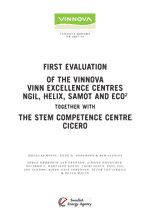In this evaluation report Vinnova - Swedish Governmental Agency for Innovation Systems and STEM - The Swedish Energy Agency present the first evaluations of the second generation of Competence Research Centres (CRCs). In 1995, NUTEK launched the first generation of CRCs providing a ten-year investment in 28 Competence Centres at 8 Swedish Universities. Vinnova and STEM took over the responsibility of the first generation CRCs and finalized that programme. The two agencies have initiated a second generation of CRCs that Vinnova calls "Vinn Excellence Centres" while STEM stayed with the name "Competence Centres". Vinnova has also initiated, together with the Swedish Research Council, a slightly modified CRC version named the Berzelii Centra Programme.
The first generation of CRCs has, generally speaking, been very well received by Swedish society. Also, in a European context, the Swedish CRC programme has a very good reputation. The aim is to achieve concentration of resources in university research to deliver strong industrial impact. This is done by creating excellent multidisciplinary research environments at the universities in which industrial companies actively participate. In the second generation of CRCs the programme has also been changed to encourage increased participation of public partners.


